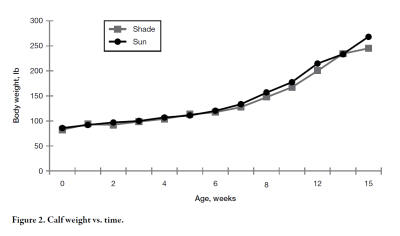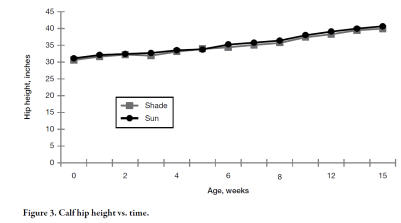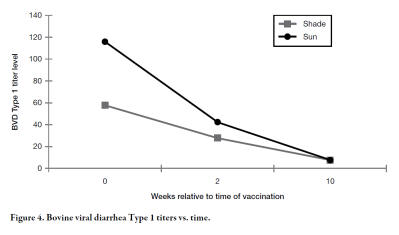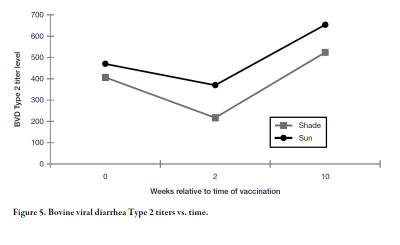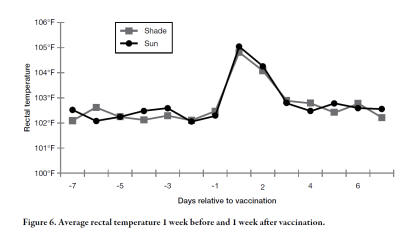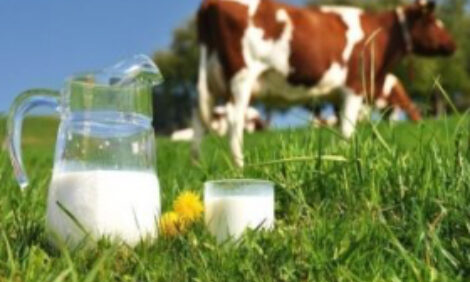



Effects Of Heat Stress On Dairy Calves
The objectives of this study by D. M. Meyer, M. J. Brouk, and L. C. Hollis were to investigate the possible effects of heat stress on calf growth and the development of active immunity.Summary
Eighteen heifer calves born between July 21 and August 24, 2008, were housed in individual hutches, and half of the calves were provided supplemental shade from birth to 8 weeks of age. During this time, milk replacer intake, dry feed intake, and fecal scores were recorded daily. Calf weight and hip and shoulder heights were measured and recorded weekly. The bovine viral diarrhea portion of the vaccine given at 5 weeks of age was used as an indicator to track the development of humoral immunity. Intake, growth, temperature response after vaccination, and serum titers did not differ significantly between treatments. In contrast, differences in hutch temperature, relative humidity, and temperaturehumidity index were observed between treatments. Results indicated that supplemental shade provided to calves housed in hutches does not affect their performance or ability to develop active immunity.
Introduction
Heat stress and disease prevention for young and aged animals are two fundamental areas of concern and study in the dairy industry. Both areas have received much individual attention concerning their relationship to performance. Effect of stress on immunisation efficacy, however, has seldom been considered.
Bovine viral diarrhea (BVD) is a single-stranded RNA virus that can decrease performance and cause a host of health-related problems in cattle, most commonly diarrhea, abortion, and immunosuppression, that generally result in secondary respiratory infection. Cattle of all ages are susceptible to BVD. It is contained in all body fluids of infected animals and transmitted primarily by aerosol. Although constant surveillance is important, immunization for BVD also is a common preventative measure in dairy herds. Vaccination generally is administered with a modified-live virus product. Furthermore, immunological response to the virus is tested easily by blood serum neutralisation titers or tissue samples. These traits make the virus valuable to this study as an indicator of the calf’s immune response.
Heat stress also has been clearly linked to decreased dry matter intake and other measures of performance including milk yield, average daily gain, and feed:gain ratio. Heat stress in cows commonly is thought to be a more relevant concern to the industry than heat stress in calves because calves produce less metabolic heat and have a greater surface area to body mass ratio with which to dissipate heat. Supplemental shade has been shown to decrease heat stress of calves housed in hutches and improve heifer performance in feedyards.
Most research concerning thermoregulatory responses to immunity development is related to passive immunity and colostral quality and immunoglobulin transfer. A recent study suggested that heat stress did not affect active immunity development of calves. Therefore, the objectives of this study were to determine the effect of heat stress on the development of BVD titers, study the effects of heat stress on intake and growth, and monitor environmental changes in order to correlate them to measures of stress in Holstein dairy calves. We hypothesized that heat stress would negatively affect calf intake, growth, and immunological response and that supplemental shade would reduce these effects.
Experimental Procedures
Each of 18 Holstein heifer calves was assigned randomly to a Calf-Tel (Hampel Corporation, Germantown, WI) hutch in either the shade or sun treatment in blocks of 2 calves each according to date of birth. Calves were weighed and hip and wither heights were recorded at birth. Calves were then weighed and measured weekly through 8 weeks of age on the day of the week they were born at about 1630 hours, just after their evening milk feeding was completed. Calves born on Sunday were weighed on Monday, and those born on Saturday were weighed on Friday. Daily morning and afternoon amounts of milk replacer and starter feed fed and refused as well as morning and afternoon fecal scores were recorded during this time. Milk replacer was fed only in the afternoon at 5 weeks of age and discontinued at 6 weeks of age.
At 8 weeks of age, calves were moved to group lots with 8 to 9 calves in each pen and housed there for the remainder of the study. Calves were weighed and measured at 10, 12, 14, and 15 weeks of age on a single day of the week as close to their actual birth date as possible.
Calves were given 2 mL TSV-2 intranasally, 2 mL Ultrabac CD subcutaneously, and 2 mL Calf-Guard orally at birth; a second 2-mL dose of Ultrabac CD was given again at 2 weeks of age. Calves were vaccinated at 5 weeks of age with 2 mL Bovi-Shield GOLD FP5L5 intramuscularly and 2 mL One Shot Ultra 7 subcutaneously. At 6 weeks of age, calves were vaccinated with 2 mL TSV-2 and 2 mL Spirovac subcutaneously. At 8 weeks of age, just before being moved to the group housing, calves also were given 2 mL of MAXI/GUARD Pinkeye Bacterin. All vaccines were provided by Pfizer Animal Health (New York, NY), except MAXI/GUARD Pinkeye Bacterin, which was provided by Addison Biological Laboratory, Inc. (Fayette, MO).
Blood samples were obtained at 5 weeks of age (immediately prevaccination), at 7 weeks of age (2 weeks postvaccination), and at 15 weeks of age (10 weeks postvaccination). Blood samples were collected into red top vacutainer (Becton Dickinson, Rutherford, NJ) tubes and allowed to clot at room temperature before centrifuging. Serum was then pipetted into 2-mL microcentrifuge tubes. Samples were frozen and analyzed together for Type 1 and 2 BVD titers by using standard serum neutralisation techniques.
Temperature and humidity of each hutch and ambient temperature were monitored continuously with data loggers throughout the study. Rectal temperatures were measured and recorded at 0600, 1100, 1600, and 2100 hours for 3 days during a period of environmental heat stress. Rectal temperatures also were measured and recorded at 0600 and 1600 hours daily for 1 week before and 1 week after vaccination.
Results and Discussion
During the study, 1 calf died because of causes unrelated to the study. Data from this calf and that of her block mate were removed before analysis. Dry feed intake did not differ significantly between treatments (Figure 1). Calf growth, as measured by weight and frame size (hip height), is shown in Figures 2 and 3. These measurements showed normal calf growth with no signifi- cant differences between treatments. Fecal scores averaged 1.2 and 1.3 for shade and sun treatments, respectively, and did not differ between treatments.
BVD Type 1 and Type 2 titers did not differ significantly between treatments (Figures 4 and 5). Type 1 titers (Figure 4) showed no increase in titer level, but rather a titer decrease typical of maternal colostral antibody depletion. Type 2 titers (Figure 5), however, initially showed maternal antibody decrease similar to Type 1 but followed with an increase in titers, suggesting a delayed active response.
Rectal temperature did not differ between treatments (Figure 6). The temperature rise immediately after vaccination (day 7) was likely caused by the adjuvant in the One Shot Mannheimia haemolytica bacterin/toxoid and the 5-way Leptospira fraction of the Bovi-Shield GOLD FP5L5, both of which are gram-negative components known to cause a rapid postvaccination temperature response. The modified-live viral fractions of the Bovi-Shield GOLD FP5L5, containing a modified-live virus, should have shown a slower temperature response because the modified-live virus needed time to replicate before it could initiate an immune response and corresponding temperature rise.
Internal hutch temperature and relative humidity (Figure 7) were measured as an average of 8 hutches (4 from each treatment). Average temperature of the sun treatment was greater (P < 0.001) than that of the shade treatment (77.2 vs. 75.9°F), whereas the relative humidity was lower (P = 0.02, 76.5 vs. 76.6 per cent). Typically, a higher temperature will result in lower relative humidity if a similar amount of water is present in the air. The greater temperature observed for the sun treatment resulted in a greater (P < 0.001) temperature-humidity index. This indicated that the environment in the sun treatment potentially could have been more stressful than the shade.

